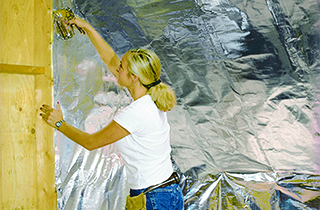Sunblock Savings

My air-conditioning costs were high last summer and we still felt too warm at times. I see ads for radiant barriers that are supposed to save a lot. How does a radiant barrier work, will it save much, and how much does it cost?—Ann T.
Energy savings claims in radiant barrier advertising are often based on extreme examples. What you save will depend on your climate zone, your home’s size, and its orientation to the sun. Since radiant barriers have little effect on energy use during the winter months, the hotter and longer the summer air-conditioning season is at your location, the more you might save.
The sun’s energy heats your home in different ways. Heat from sunlight hitting your roof’s shingles moves by conduction into everything that’s directly connected to the roof, including beams, rafters, and walls. When sunlight warms the air around your home, that heat can be transferred to your house by convection.
You’ve experienced radiant energy when you feel warm sitting near a fire—you’re not actually in contact with the flames but you still feel their heat. Radiant barriers are designed to interrupt the way that kind of energy from the sun warms your home. They work two ways: by reflecting some of the sun’s radiant energy away from your home’s interior, and by blocking its movement into your home.
Do-it-yourself savings
On a hot summer afternoon, dark shingles on a roof can easily reach 150 degrees. Anything you can do to keep that much heat from reaching the interior of your home will make you feel more comfortable, keep your air-conditioning system from running too often, and lower your electricity use.
Radiant barriers, made of special foil or film, are usually sold in rolls that are 4 feet wide by 250 feet long, and cost less than $150. To get the quickest payback in terms of lower electricity use in the future, it makes sense to install the radiant barrier yourself.
The only tools you’ll need are a construction grade stapler, a utility knife, and a long straight edge to use as a cutting guide.
Cut easy-to-handle lengths from the roll and staple each across the roof rafters. Neatness isn’t important, as long as you achieve a continuous barrier with no gaps. When installing single-sided foil, face the reflective side down for best results.
SHOPPING SECRETS
Check the rating number for the best barrier material
Whether you plan a do-it-yourself project or will be hiring a professional to install radiant barriers, check the numbers on the products or in the contract. Compare the “emittance” factor on the barrier or in the installation contract. The lower the number, the more effective the material will be in preventing heat gain—and the better energy savings you can expect.
Mail requests and questions to JAMES DULLEY, Kentucky Living, 6906 Royalgreen Drive, Cincinnati, OH 45244, or visit www.dulley.com.

